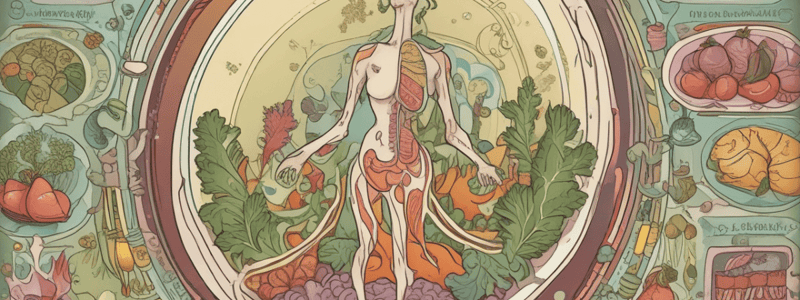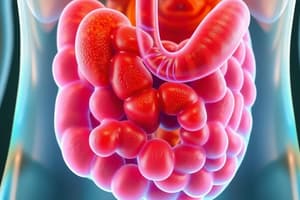Podcast
Questions and Answers
What is the main function of carbohydrates in the diet?
What is the main function of carbohydrates in the diet?
- To provide a source of energy (correct)
- To allow for absorption of water-soluble vitamins
- To regulate blood sugar levels
- To provide fibre and protein
What is the main difference between soluble and insoluble carbohydrates?
What is the main difference between soluble and insoluble carbohydrates?
- Soluble carbohydrates are resistant to breakdown by enzymes, while insoluble carbohydrates can be broken down
- Soluble carbohydrates are complex, while insoluble carbohydrates are simple
- Soluble carbohydrates are found in plants, while insoluble carbohydrates are found in animals
- Soluble carbohydrates can be broken down by enzymes, while insoluble carbohydrates are resistant to breakdown (correct)
What is the function of lignin in the diet?
What is the function of lignin in the diet?
- To reduce the digestibility of fibre and protein (correct)
- To increase the digestibility of fibre and protein
- To provide a source of energy
- To regulate blood sugar levels
What is the structure of a triglyceride?
What is the structure of a triglyceride?
What is the function of fat in the diet?
What is the function of fat in the diet?
Where does the digestion of fat take place?
Where does the digestion of fat take place?
What is the role of lipase in the digestion of fat?
What is the role of lipase in the digestion of fat?
What is the characteristic of triglycerides in terms of solubility?
What is the characteristic of triglycerides in terms of solubility?
What is the role of bile in the digestion of fats?
What is the role of bile in the digestion of fats?
What is the fate of excess ammonia in the body?
What is the fate of excess ammonia in the body?
What is the main function of proteins in the body?
What is the main function of proteins in the body?
What does the term ME stand for in the context of energy partitioning?
What does the term ME stand for in the context of energy partitioning?
What is the term for the energy lost as heat during metabolism?
What is the term for the energy lost as heat during metabolism?
Flashcards are hidden until you start studying
Study Notes
Carbohydrates
- A source of energy, composed of Carbon, Hydrogen, and Oxygen
- Form the major component of plant DM (approximately 75%)
- Concentrates consist predominantly of CHO
- Carbohydrates are either:
- Soluble (non-structural): can be broken down by enzymes in GIT, examples include glucose, fructose, lactose, sucrose, and starch
- Insoluble (structural): resistant to breakdown by enzymes produced by the GIT, examples include cellulose, hemicellulose, and pectin
- Lignin is completely indigestible and reduces the digestibility of other dietary components, particularly fibre and protein
Types of Carbohydrates
- Monosaccharides:
- Simple sugars, cannot be broken down further
- Disaccharides:
- Composed of two monosaccharides, examples include sucrose, lactose, and maltose
- Trisaccharides:
- Composed of three monosaccharides, example includes raffinose
- Polysaccharides:
- Composed of many monosaccharides, examples include starch, cellulose, and glycogen
Whole Grain Cereals
- Contain substantial quantities of starch in the form of amylose and amylopectin in the endosperm
Fat and Energy in the Diet
- Fat is composed of triglycerides, which are organic compounds insoluble in water and soluble in organic solvents
- Structure: composed of glycerol (backbone) and 3 fatty acids
- Simple triglyceride: composed of 3 identical fatty acids
- Mixed triglyceride: composed of different fatty acids
- Functions of fat in the diet:
- Source of available energy
- Source of essential fatty acids
- Allows for absorption of fat-soluble vitamins (A, D, E, K)
- Component of cell membranes (phospholipids, glycolipids, sterols)
- Insulation and protection
Digestion of Fat
- Fat globule is difficult to digest in the stomach, so it is moved directly to the small intestines
- Lipase from the pancreas causes the breakdown of fatty acids
- Bile:
- Activates the pancreatic lipase
- Helps emulsify fats (reduces the size)
Protein
- Consists of amino acids joined together to form proteins
- Essential and non-essential amino acids
- Examples of essential amino acids: arginine, histidine
- Examples of non-essential amino acids: alanine, glycine
- Majority of protein in the diet is broken down to ammonia
- Excess ammonia that is not needed in the body is converted to urea and excreted in urine
- Functions of protein:
- Growth and repair of cells
- Drives metabolic reactions
- Maintains pH and fluid balance
Metabolism and Measurement of Energy in Ruminants
- The partitioning of feed energy:
- DE ( Digestible Energy) = proportion of feed energy that does not appear in the faeces
- ME (Metabolizable Energy) = not all available, products excreted in urine and gases also contain energy
- NE ( Net Energy) = energy is lost as heat during metabolism - HIF (Heat Increment of Fermentation)
Studying That Suits You
Use AI to generate personalized quizzes and flashcards to suit your learning preferences.



